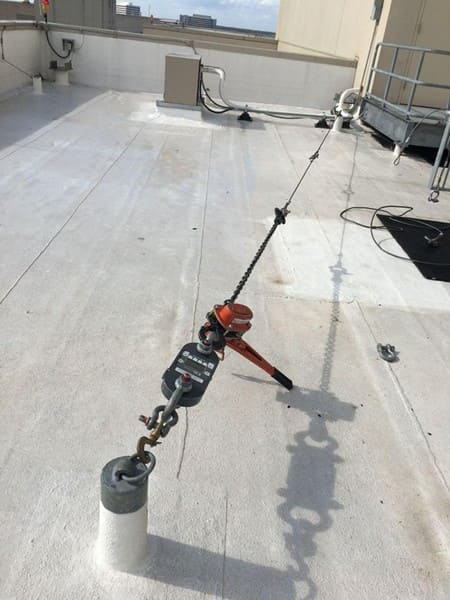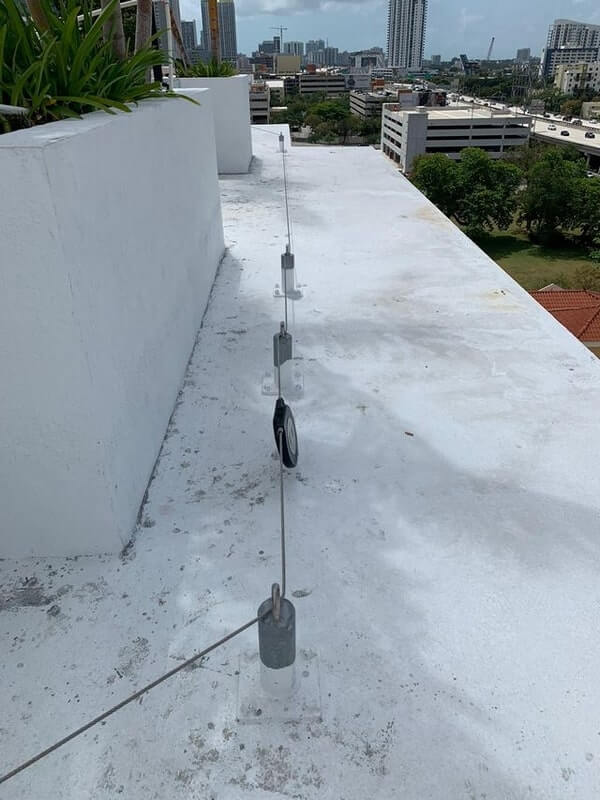OSHA Roof Anchor Standards
Periodic testing of roof anchors is essential for keeping your workers safe and is also required by the Occupational Safety and Health Administration (OSHA). Testing is required following installation and every 10 years thereafter during the recertification process.
Fall protection anchor points are a vital part of keeping your workers safe on the job site, whether they’re doing rooftop maintenance, window washing, or even something as simple as retrieving a lost ball on an elementary school roof. But just like the saying goes, “a team is only as strong as its weakest member,” a fall protection safety system is only as strong as its weakest anchor.
Note that equipment secured with adhesive anchor bolts is required to be tested at 5-year intervals. Load Testing MUST be performed under the direction and supervision of a Professional Engineer by a properly trained and certified professional. However, your roof anchor certification does not have to be done by the same organization that installed the anchors.

Requirements for roof anchor testing
Roof anchor testing is vital to ensure safety and compliance with regulatory standards. It also makes sure that the roof anchor remains optimal for roof fall protection.
OSHA regulations mandate that all rooftop safety anchors “be capable of supporting at least 5,000 pounds (22.2 kN) per employee attached; or designed, installed, and used, under the supervision of a qualified person, as part of a complete personal fall protection system that maintains a safety factor of at least two.”, as per OSHA 1910.140(c)(13).
Since OSHA section 1910.140(d)(1)(i) states that a fall arrest system must “limit the maximum arresting force on the employee to 1,800 pounds (8 kN)”, so “a safety factor of at least two” would mean that your fall arrest system can maintain a maximum force of 3,600 pounds (16 kN) of force.
Why roof anchor testing is important
It almost goes without saying that testing of the roof anchor is a quality control measure. Load testing of fall protection and suspended access equipment is implemented to field verify the design and engineering of the following three things:
- Anchor Strength
- Connection of the Anchor to the Structure
- Base Building Structure
Following the initial load testing, annual visual inspection, and the recertification load testing discussed above, continue to verify the integrity of these three things over time.
Types of Roof Anchor Testing
There are two main types of roof anchor testing: Dynamic Load Testing and Static Load (also known as Pull Testing). To be a properly certified fall protection system, an anchor must pass both types of testing, and every anchor on the system must be individually certified.

Dynamic or Live Load testing
It is not a common practice in the field and is mainly used in factory testing methods. Dynamic load testing, in layman’s terms, is dropping weight from the anchor point and observing or measuring the outcome.
This is not practical in the field as testing equipment must be completed in the direction of use, which is, more often than not, over the side of the building when on a roof. The most common method of load testing is Static load testing.
Static Load testing
Static load testing involves applying a static or continuous load to the tieback anchor. This is accomplished by attaching a hydraulic load testing device and increasing the load applied to the anchor to achieve the required load specified in the Load Test Prescription, which is prepared by a Professional Engineer and certifies the equipment. The following are a few typical methods Pro-Bel implements in the field:
- Pull Testing: pulling horizontally between two anchor points.
- Tripod Test: pulling vertically on a single anchor point
- Suspended Weight Test: loading a steel basket with weights to achieve the prescribed load.
How Pro-Bel can help you
Pro-Bel employs a team of licensed engineers who have extensive knowledge, training, and experience to perform roof anchor inspections.
We offer multi-year inspection programs to perform superior inspections and testing, helping building owners meet compliance requirements.
Our competent experts have significant expertise in testing
- permanent roof anchors
- bolt-through roof anchors
- adhesive roof anchors
- cast-in-place roof anchors,
- welded roof anchors
- soffit roof anchors
- wall anchors
- wrap-around roof anchors
When conducting a roof anchor inspection, Pro-Bel can provide:
- Review of the roof anchor system
- Annual deficiency inspection
- Technical audit/compliance inspection
- Roof assessment
- Recommendations for load testing and re-certification of existing equipment (if necessary)
We provide inspection services to ensure your roof anchors comply with OSHA, ANSI, ASME, and IWCS standards. Our experts provide a detailed report outlining the inspection and identifying potential compliance issues.
At Pro-Bel, we can handle the inspection, testing, and certification of all your fall protection systems and tieback anchors, as well as the design and installation aspects of these systems. This ensures the safety of your workers and alleviates stress for you and your team.
Contact Pro-Bel today for more information about how our team of competent experts can help you maintain OSHA roof anchor requirements.
Share this Post

